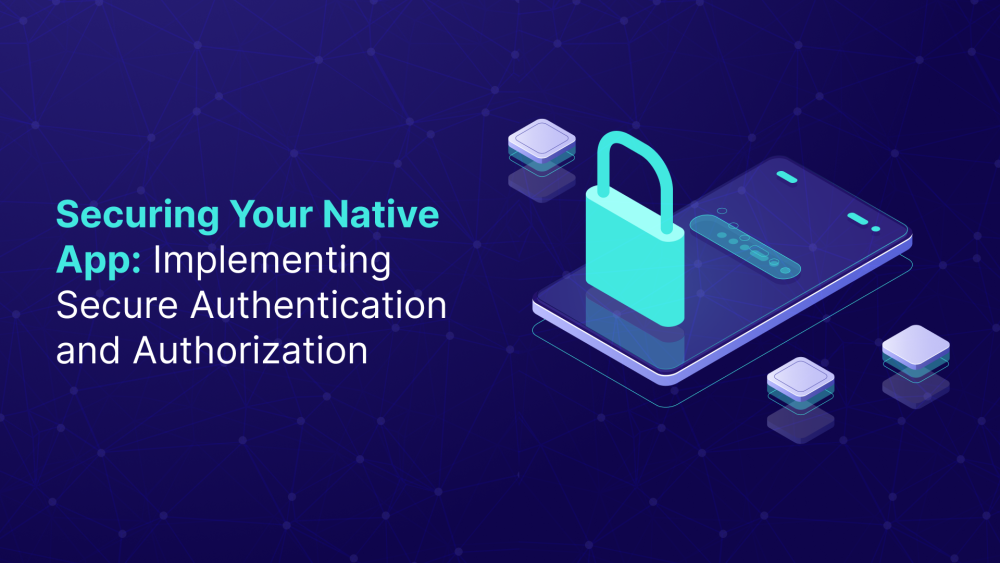In today's data-driven world, mobile applications hold a treasure trove of user information. From financial credentials to personal health data, robust security measures are paramount. Authentication and authorization protocols act as the gatekeepers, verifying user identities and controlling access to sensitive functionalities within your native app. This blog delves into the world of secure authentication and authorization for native apps, exploring popular protocols, integration best practices, and the latest advancements that empower developers to build impregnable mobile experiences.
Why Secure Authentication and Authorization Matter
Data breaches involving mobile apps are on the rise. A report by Verizon highlights that 43% of all data breaches in 2023 involved stolen credentials [Source: https://www.verizon.com/business/resources/reports/dbir/ ]. Inadequate authentication and authorization protocols leave apps vulnerable to unauthorized access, potentially exposing sensitive user data and compromising core functionalities. Here's why prioritizing these protocols is crucial:
-
Enhanced User Trust: Robust authentication mechanisms build user confidence and trust in your app. Users are more likely to engage with an app that demonstrably safeguards their data.
-
Improved Security Posture: Implementing strong authorization protocols minimizes the attack surface, restricting access to sensitive features and data based on user roles and permissions.
-
Compliance with Regulations: Many industries, such as healthcare and finance, are subject to stringent data privacy regulations. Secure authentication and authorization protocols ensure compliance with these regulations.
Popular Authentication and Authorization Protocols for Native Apps
Several well-established protocols form the backbone of secure authentication and authorization in native apps:
1. Username and Password-Based Authentication:
This traditional method remains widely used. Users establish credentials (username and password) that are verified against a server-side database during login attempts.
Pros: Simple to implement, widely understood by users.
Cons: Prone to brute-force attacks, vulnerable to credential phishing.
2. Multi-Factor Authentication (MFA):
MFA adds an extra layer of security by requiring users to provide a secondary verification factor, such as a one-time code sent via SMS or generated by an authenticator app, in addition to their username and password.
Pros: Significantly enhances security compared to username/password alone.
Cons: May introduce slight inconvenience for users, potential for SIM-swapping vulnerabilities with SMS-based MFA.
3. OAuth and OpenID Connect:
These open standard protocols enable secure delegation of user authentication. Users log in using their existing credentials from trusted providers like Google or Facebook, eliminating the need to manage separate credentials for your app.
Pros: Improved user experience, eliminates password storage on your app's servers, leverages established security infrastructure of providers.
Cons: Relies on the security practices of third-party providers, potential privacy concerns for users sharing data with external services.
4. Biometric Authentication:
Emerging technologies like fingerprint scanners and facial recognition offer a convenient and secure way to authenticate users.
Pros: Highly secure, eliminates the need to remember passwords.
Cons: Limited device compatibility, potential for spoofing attacks on some systems.
Integration Best Practices for Secure Authentication and Authorization
Here are some key considerations when integrating authentication and authorization protocols into your native app:
-
Secure Communication: Always use HTTPS to encrypt communication between your app and the server during authentication and authorization processes. This prevents data interception by malicious actors.
-
Password Hashing and Storage: Never store passwords in plain text. Utilize strong hashing algorithms like bcrypt to securely store password representations on the server.
-
Regular Security Audits: Conduct periodic security audits of your app and server infrastructure to identify and address potential vulnerabilities.
-
Token-Based Authorization: Implement token-based authorization after successful authentication. Tokens act as temporary access permits, minimizing the exposure of sensitive credentials during subsequent API calls within the app.
Industry-Specific Considerations
The specific authentication and authorization protocols you choose will depend on the nature of your app and the industry it operates in. Here are some examples:
-
Fintech Apps: MFA and biometrics are crucial for financial transactions, along with compliance with regulations like PCI DSS.
-
Healthcare Apps: OAuth with healthcare providers like Open EHR could be suitable for secure access to patient data, adhering to HIPAA regulations.
-
E-commerce Apps: Social logins via OAuth can simplify user experience, while token-based authorization is essential for secure payment processing.
The Future of Authentication and Authorization: Emerging Trends
The landscape of secure authentication and authorization is constantly evolving. Here are some exciting trends to keep an eye on:
-
Passwordless Authentication: Emerging technologies like FIDO2 are paving the way for passwordless logins using biometrics or security keys.
-
Continuous Authentication: Moving beyond one-time logins, continuous authentication monitors user behavior and adapts security measures in real-time, mitigating the risk of unauthorized access even after successful login.
-
Machine Learning-Powered Security: Machine learning algorithms can analyze user behavior patterns to detect anomalies and potential fraudulent activities, adding an extra layer of security.
Conclusion: Building a Secure Foundation for Your Native App
By prioritizing secure authentication and authorization protocols, you can build a robust foundation for your native app. Choosing the right protocols, implementing them securely, and staying abreast of emerging trends will ensure a trustworthy and secure user experience. Remember, a secure app is not just about protecting user data, it's about fostering trust, loyalty, and a competitive edge in the ever-evolving mobile landscape.
Evaluate your current authentication and authorization practices. Consider incorporating the latest advancements and best practices discussed above to fortify your native app's security posture. By prioritizing user data security, you can build a mobile experience that users can confidently rely on.


